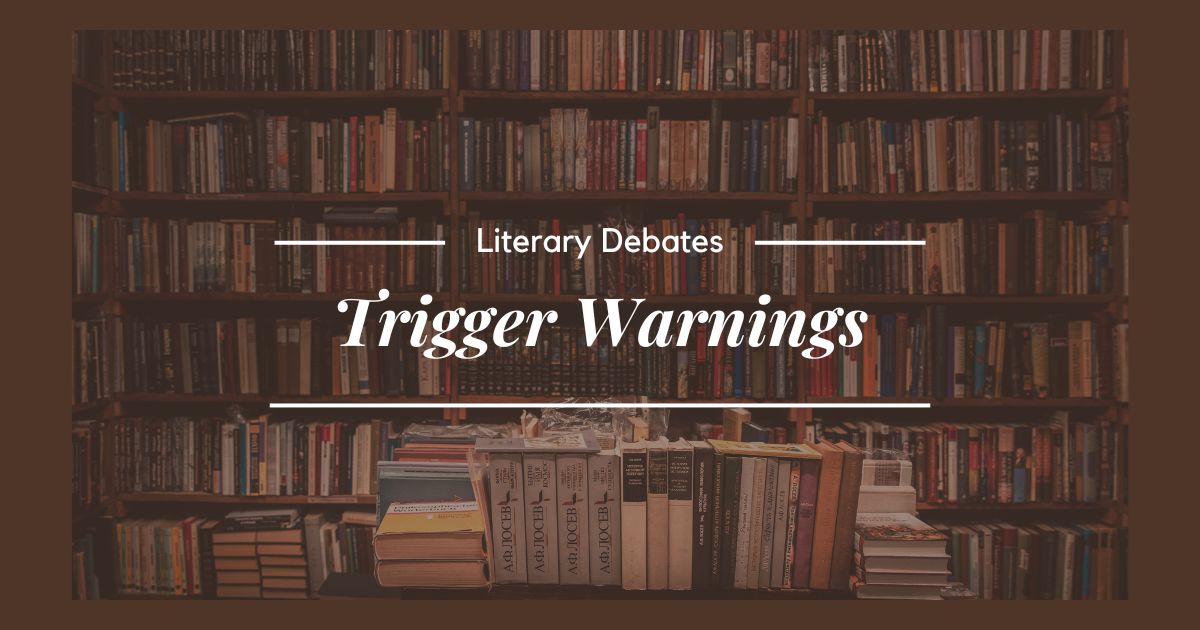If you’re part of any online book group, you’ve likely seen the occasional debate crop up on the “controversial” topic of trigger warnings. There always seem to be two types of people responding:
- The in-favor camp, who prefer trigger warnings themselves due to trauma, and if not, express genuine concern for the mental health of their fellow readers who do
- The opposing camp, who argue that trigger warnings coddle people by helping them avoid difficult feelings or topics, and that they can be spoilers
And of course, there’s the trigger-warning agnostic party, which is most likely the largest group but who often just don’t participate in the discourse at all.
Let’s hash this out.
What are trigger warnings and where did they come from?
Trigger warnings are the same as content warnings, and are similar to what you find in the content rating on a movie. Their primary function is to warn readers about content they might find disturbing, unpleasant, or – to use the keyword – triggering.
A lot of this debate originated as a discussion on college campuses. Some students wanted trigger warnings made available for courses so they fully understood what they were agreeing to learn and discuss. Some felt this was a breach of academic integrity, that it unnecessarily babied the students and encouraged them to avoid difficult lessons. Others argued that this would reinforce to PTSD and trauma victims that their triggers were a central part of their identity – though this is just conjecture.
It’s important to note that the research on trigger warnings is mixed. There is no definitive science to argue that they are effective or ineffective at reducing distress.
However, in my opinion, what applies to a college classroom does not apply to reading. Because reading is a hobby.
Educational settings are meant for just that: education. We attend school to grow our minds, spirits, and marketable skill sets. We may read or discuss confronting topics in the name of learning.
But we read our dragon-filled, steamy fantasy romance for FUN. We’re here for a good time. Yes, we can learn a lot from reading widely, and we should. But outside of school and work, the truth is that we do it because we love it. And if certain topics, imagery, descriptions, or plot points would turn a book from a fun romp into a PTSD-fueled nightmare, why wouldn’t we use trigger warnings?
Are trigger warnings spoilers?
I can understand why some readers feel this way. It’s one thing when the warnings say vague things like “violence” or “body horror.” But it can feel like another thing entirely if it says “miscarriage” or “death of a loved one.” It sometimes feels like these give away important plot points.
However, there’s something really important about this. And it’s that you don’t have to read the trigger warnings.
There are those who really can’t read about heavy topics like that, and if they’re featured prominently in the book, those readers deserve to know before diving in. For those who do not find any content triggering, skipping over the warnings is the best course of action.
Should writers care about this?
In my opinion, yes. I often see comments from writers who are disgruntled by this added expectation. It makes sense that, after all the time and dedication to writing a book, adding a new responsibility to the plate can feel like an unnecessary lift. But it can actually help a book.
Proper trigger warnings can help prevent a book from receiving a litany of one-star reviews from those who would find its content too disturbing to enjoy. There are many reviewers who might feel compelled to warn off others if they’re blindsided by a book that didn’t come with trigger warnings. Writers can beat them to the punch, and anyway, showing compassion for readers goes a long way.
Where to find trigger warnings
Many books do not have trigger warnings built in, but there are still trustworthy places to find them if needed. (I’m not affiliated with any of the below, these are just the sites I know)
- Storygraph, which is similar to Goodreads in that it’s a place to review books, read other reviews, and log your reading. But it has two distinct advantages over Goodreads, in my opinion. The first is that it compiles your reading data and gives you unique insights into your preferences and reading habits. The other is that readers can log trigger warnings with their reviews, and you can see those warnings compiled on a book’s page.
- Book Trigger Warnings, which is exactly what it sounds like. It’s a wiki of trigger warnings for a user-created database of books.
- Trigger Warning Database, a WordPress blog created by a team of readers and writers that allows you to peruse by book or by trigger.
Check out some of my other recent blogs:
- The Starving Saints: Excellent fantasy horror
- The Bog Wife: Finally, a 5-star read
- April memes
- The Rom-Commers: Mostly good
- The Jasad Heir (Book 1): Fun, but not standout









2 responses to “On Trigger Warnings: A common literary debate”
I think they are a must! Not just for me but other readers who might find some things difficult to read, and that’s completely okay. And it doesn’t cost them a thing! Why is it a problem? Also, I’ve seen lots of discussions about the age recommendations in books and how 15 year olds (or even younger people) are reading books marked as adolescent reads when they have explicit sex scenes and violence, etc, I would love to read your opinion on that topic as well! 🩷
Yes that’s a great point too! Publishers seem to be pretty inconsistent about what kind of content even qualifies as Young Adult. I talk about it a little bit in this blog: YA vs. NA — but it’s definitely something to talk more about.